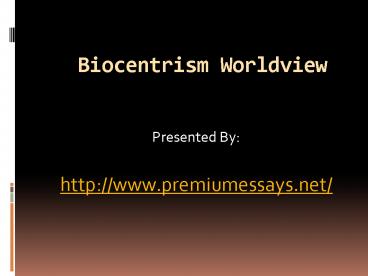Biocentrism Worldview - PowerPoint PPT Presentation
Title:
Biocentrism Worldview
Description:
Our major goal is to help you achieve your academic goals. We are commited to helping you get top grades in your academic papers.We desire to help you come up with great essays that meet your lecturer's expectations.Contact us now at – PowerPoint PPT presentation
Number of Views:547
Title: Biocentrism Worldview
1
Biocentrism Worldview
- Presented By
- http//www.premiumessays.net/
2
Introduction
- Biocentrism was defined by Lanza and Barman .
- It is the belief that the needs and rights of
human beings are not more important than those of
other living things. - It puts great emphasis on equal consideration for
all living things. - Biocentrism beliefs and theories have closely
been associated with indigenous traditional
practices . - The essay is going to discuss biocentrism concept
which is inherent in tradition of Karma in
Hinduism and kami in Shinto beliefs..
3
Kami
- Principle of kami in Shinto practices focus on
power of nature and the universe. - Kami is a spirit that was created from heavens
and is present in all objects. - Uniqueness of Shinto tradition lies in the belief
the spirits of kami. - They be it lives in all animals and objects of
the universe. - Shinto believers assert kami is found in
inanimate animals, objects, physical features as
well as plants
4
Relation to Biocentrism
- There is acceptance of biocentric perspective in
plants and animals . - Shinto believers have great reverence for all
plants and animals. - They believe the kami spirit dwells in all living
things and objects. - Shinto believers consider, selected animals,
plant, and physical features. - These have demonstrated abilities that are
supernatural.
5
Ethical Implications of Kami Belief
- Kami principle is attributed to realization of
self-awareness among Shinto believers. - Shintos doctrine of kami emphasis importance of
appreciating oneself as well as objects in the
universe. - Yamakage (2012) makes the argument that belief
that kami exists in all living things . - The spiritual world, through kami has been
transformed into bodies of plants and animals. - Co-existence between humans and constituents of
the ecosystem has contributed to interaction that
is harmonious between flora and fauna in the
ecosystem.
6
Karma
- Karma doctrine is a major fundamental pillar in
Hinduism. - Karma states that actions/thoughts of individual
results to the outcome in their lives. - These can be immediately, in near future or in
some cases, in the afterlife. - Through incarnation, the soul of an individual
continues its journey suffering repercussions .
7
Karma Doctrines and biocentric worldviews
- Large percentage of Hindus have adopted
vegetarian diets. - They are motivated by incarnation and karma
beliefs. - These are that they could be hurting their
relatives who might have transformed into animals
in their afterlife. - They are known as Jains.
- These are pure vegetarians.
8
Ethical Implications of the Karma Doctrine
- Actions of an individual are related directly to
their consequences. - Hindus thus practice righteousness and embraced
harmony. - Vegetarians have also indirectly contributed to
maintenance of ecosystem. - Adoption of conservative approach in their
relationships with both wild and domestic animals.
9
Similarities between the Concept of Kami and
Karma
- Both these concepts lay emphasis on the role
played by the universe . - This balances coexistence between the different
elements of the environment. - Two traditions focus on individual consequences
in future. - These indicate roles of a believers effort in
attainment of spiritual state and
self-righteousness.
10
Differences between the Concept of Karma and Kami
- They are guiding doctrines to believers of Shinto
and Hinduism. - Karma consequences are likely to be experienced
by believers in afterlife. - Hindus strongly believe that they might be
transformed to other organisms in their
afterlife. - Presence of spirits within the organism
demonstrates the belief of kami from the karma
doctrine. - Karma however, does not entail spiritual
possession of influence of a God.
11
References
- Lanza, R. Berman, B. (2010). Biocentrism How
Life and Consciousness Are The Key To
Understanding The True Nature Of The Universe.
Dallas, TX Ben Bella Books. - Ono, S., Woodard W. (2004). Shinto the Kami
Way. North Claredon, VT Tuttle Publishing. - Ratnakar, P. (2005). Hinduism (Evolution and
Current Practices).New Delhi Lustre Press. - Underwood, C. (2012). Shintoism The Indigenous
Religion of Japan. Yorkshire West Yorkshire
Pomona Press. - Yamakage, M. (2012). The Essence of Shinto
Japans Spiritual Heart. New York City, NY
Kodansha USA.
12
See More About Biocentrism Worldview
- At
- http//www.premiumessays.net/































